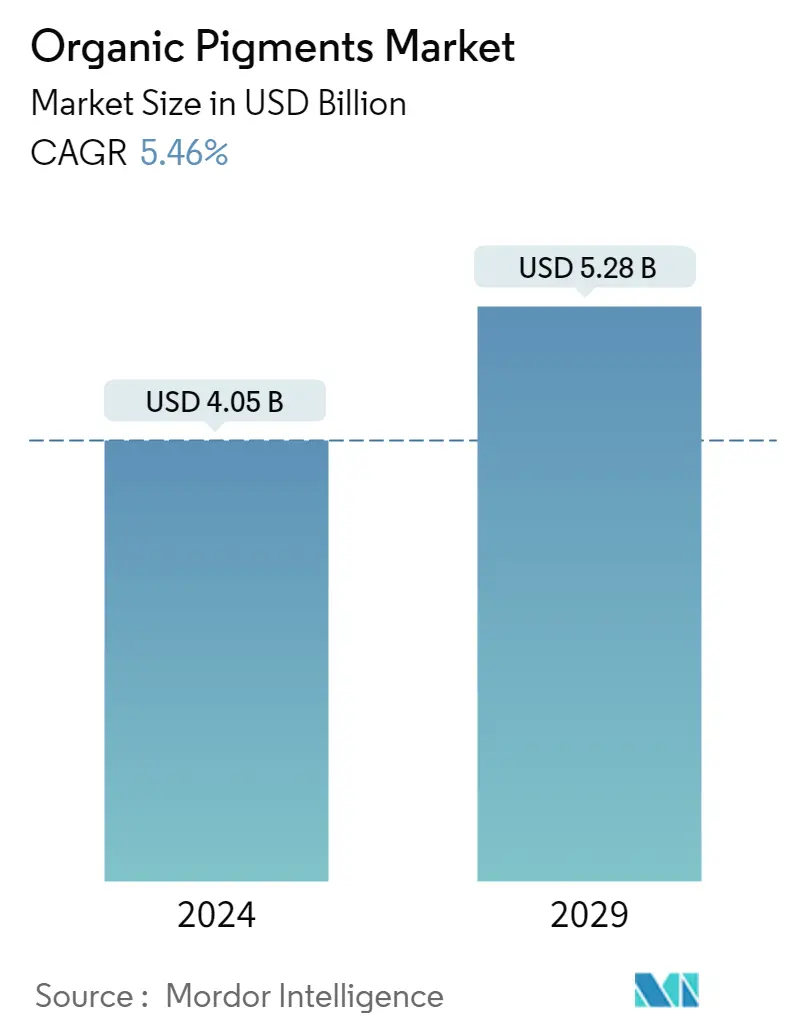Market Size of Organic Pigments Industry

| Study Period | 2019 - 2029 |
| Market Size (2024) | USD 4.05 Billion |
| Market Size (2029) | USD 5.28 Billion |
| CAGR (2024 - 2029) | 5.46 % |
| Fastest Growing Market | Asia Pacific |
| Largest Market | Asia Pacific |
Major Players
*Disclaimer: Major Players sorted in no particular order |
Organic Pigments Market Analysis
The Organic Pigments Market size is estimated at USD 4.05 billion in 2024, and is expected to reach USD 5.28 billion by 2029, growing at a CAGR of 5.46% during the forecast period (2024-2029).
- The COVID-19 pandemic harmed the global organic market. The organic pigments industry was impacted by a disrupted global supply chain and reduced demand from end-user sectors, particularly the paints and coatings sector. Manufacturers suspended output during lockdowns, leading to a decrease in demand. Currently, the market has recovered from the pandemic and is growing at a significant rate.
- Over the short term, growing demand in the paints and coatings industry and an increase in the demand from the textile industry are driving the market.
- On the flip side, higher production costs due to stringent environmental regulations and the superior performance of inorganic pigments to organic pigments are hindering the growth of the organic pigments market.
- Nevertheless, the furniture industry is anticipated to have significant growth potential. Organic pigments aid in the protection of wood against moisture and spills. These natural colors can provide long-lasting beauty and decorative appeal to this furniture. Its potential for expansion is expected to boost the market's total supply rate.
- The Asia-Pacific region dominates the global organic pigment market, with the highest consumption rates being registered in China, India, and Japan.
Organic Pigments Industry Segmentation
Pigments are a set of compounds used for coloring other materials. Organic pigments are often brighter, more powerful, and more clear than inorganic pigments. However, they are not as light-resistant. They could be partially soluble in many thermoplastics, but they have a significantly higher tendency to migrate.
The organic pigments market is segmented by pigment type, end-user industry, and geography. By pigment type, the market is segmented into azo, phthalocyanine, quinacridone, anthraquinone, and other pigment types. By end-user industry, the market is segmented into paints and coatings, plastics and polymer, printing and packaging, textile, and other end-user industries. The report also offers market size and forecasts for 15 countries across major regions.
For each segment, market sizing and forecasts have been done based on revenue (USD) for all the above segments.
| Pigment Type | |
| Azo | |
| Phthalocyanine | |
| Quinacridone | |
| Anthraquinone | |
| Other Pigment Types |
| End-user Industry | |
| Paints and Coatings | |
| Plastics and Polymer | |
| Printing and Packaging | |
| Textile | |
| Other End-user Industries |
| Geography | |||||||
| |||||||
| |||||||
| |||||||
| |||||||
|
Organic Pigments Market Size Summary
The organic pigments market is poised for significant growth, driven by increasing demand in the paints and coatings industry, as well as the textile sector. Despite the initial setbacks caused by the COVID-19 pandemic, which disrupted global supply chains and reduced demand, the market has shown resilience and is on a recovery path. Organic pigments are particularly valued in the paints and coatings industry for their ability to provide bright colors, good dispersion, and high tinting strength, making them essential for both decorative and protective applications in various sectors, including automotive and construction. However, the market faces challenges such as higher production costs due to stringent environmental regulations and competition from inorganic pigments. Nonetheless, the furniture industry presents a promising opportunity for growth, as organic pigments offer protective and aesthetic benefits for wood products.
The Asia-Pacific region is expected to dominate the organic pigments market, with countries like China and India leading in consumption and production. The region's growth is supported by robust infrastructure and construction activities, particularly in India, where significant investments are being made in infrastructure development. This growth is further bolstered by the expanding automotive sector, driven by initiatives like 'Make in India' and increased investments in electric vehicles. Additionally, organic pigments find applications in the plastics industry due to their opacity and heat stability, with the demand for plastics anticipated to rise due to ongoing innovations. The market is characterized by a fragmented landscape with key players such as BASF SE, Sudarshan Chemical Industries Limited, and Heubach GmbH, who are actively engaging in strategic initiatives to enhance their market presence.
Organic Pigments Market Size - Table of Contents
-
1. MARKET DYNAMICS
-
1.1 Drivers
-
1.1.1 Growing Demand from the Paints and Coatings Industry
-
1.1.2 Increase in Demand from the Textile Industry
-
1.1.3 Other Drivers
-
-
1.2 Restraints
-
1.2.1 Higher Production Costs Due to Stringent Environmental Regulations
-
1.2.2 Superior Performance of Inorganic Pigments to Organic Pigments
-
-
1.3 Industry Value Chain Analysis
-
1.4 Porter's Five Forces Analysis
-
1.4.1 Bargaining Power of Suppliers
-
1.4.2 Bargaining Power of Buyers
-
1.4.3 Threat of New Entrants
-
1.4.4 Threat of Substitute Products and Services
-
1.4.5 Degree of Competition
-
-
-
2. MARKET SEGMENTATION (Market Size in Value)
-
2.1 Pigment Type
-
2.1.1 Azo
-
2.1.2 Phthalocyanine
-
2.1.3 Quinacridone
-
2.1.4 Anthraquinone
-
2.1.5 Other Pigment Types
-
-
2.2 End-user Industry
-
2.2.1 Paints and Coatings
-
2.2.2 Plastics and Polymer
-
2.2.3 Printing and Packaging
-
2.2.4 Textile
-
2.2.5 Other End-user Industries
-
-
2.3 Geography
-
2.3.1 Asia-Pacific
-
2.3.1.1 China
-
2.3.1.2 India
-
2.3.1.3 Japan
-
2.3.1.4 South Korea
-
2.3.1.5 Rest of Asia-Pacific
-
-
2.3.2 North America
-
2.3.2.1 United States
-
2.3.2.2 Canada
-
2.3.2.3 Mexico
-
-
2.3.3 Europe
-
2.3.3.1 Germany
-
2.3.3.2 United Kingdom
-
2.3.3.3 Italy
-
2.3.3.4 France
-
2.3.3.5 Rest of Europe
-
-
2.3.4 South America
-
2.3.4.1 Brazil
-
2.3.4.2 Argentina
-
2.3.4.3 Rest of South America
-
-
2.3.5 Middle-East and Africa
-
2.3.5.1 Saudi Arabia
-
2.3.5.2 South Africa
-
2.3.5.3 Rest of Middle-East and Africa
-
-
-
Organic Pigments Market Size FAQs
How big is the Organic Pigments Market?
The Organic Pigments Market size is expected to reach USD 4.05 billion in 2024 and grow at a CAGR of 5.46% to reach USD 5.28 billion by 2029.
What is the current Organic Pigments Market size?
In 2024, the Organic Pigments Market size is expected to reach USD 4.05 billion.

